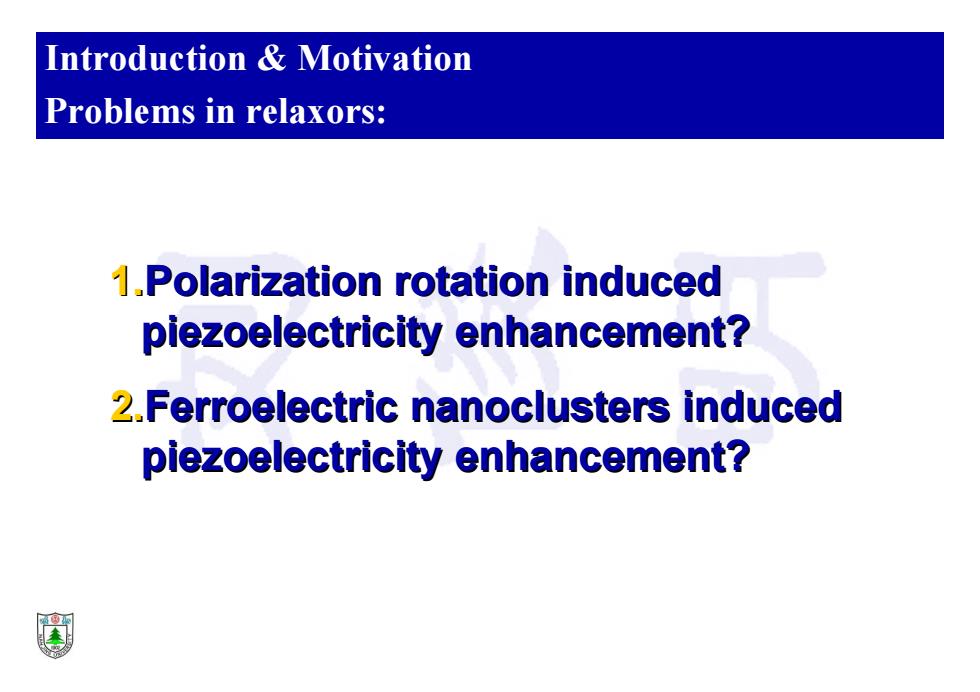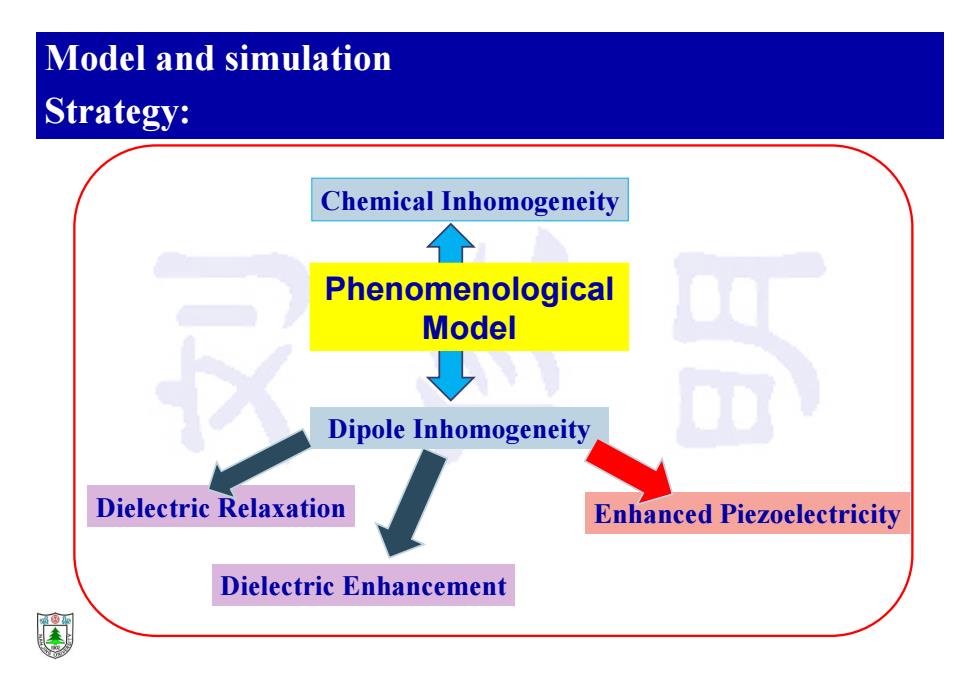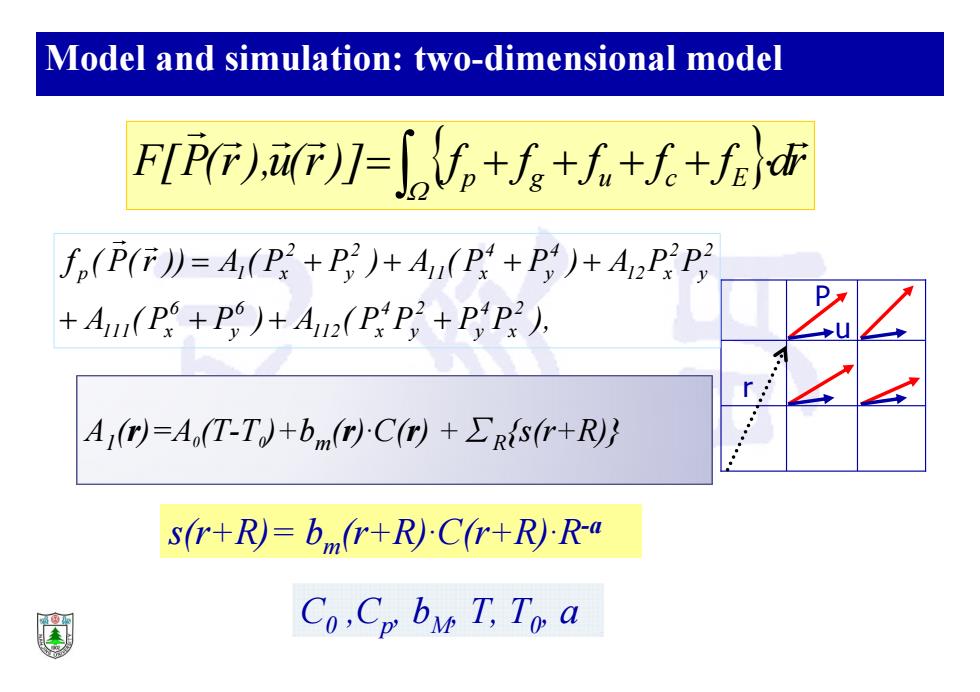
Introduction Motivation Problems in relaxors: 1.Polarization rotation induced piezoelectricity enhancement? 2.Ferroelectric nanoclusters induced piezoelectricity enhancement?
Introduction & Motivation Problems in relaxors: 1.Polarization rotation induced Polarization rotation induced piezoelectricity enhancement? piezoelectricity enhancement? 2.Ferroelectric Ferroelectric nanoclusters nanoclusters induced induced piezoelectricity enhancement? piezoelectricity enhancement?

Model and simulation Strategy: Chemical Inhomogeneity 合 Phenomenological Model Dipole Inhomogeneity Dielectric Relaxation Enhanced Piezoelectricity Dielectric Enhancement
Model and simulation Strategy: Phenomenological Model Chemical Inhomogeneity Dipole Inhomogeneity Enhanced Piezoelectricity Dielectric Enhancement Dielectric Relaxation

Model and simulation:two-dimensional model FF),F)=。+方++人+f面 f(P()=4(P+P)+Au(P+P:)+APP +Am(p+p)Au(P:+P) Aj(r)=Ao(T-T+bm(r)C(r)+>Rs(r+R) s(r+R)=br(r+R)-C(r+R)-R-a Co,Cp by T,To a
Model and simulation: two-dimensional model P u F[P(r), u (r)] f f f f f dr p g u c E A ( P P ) A ( P P P P ), f ( P ( r )) A ( P P ) A ( P P ) A P P 2 x 4 y 2 y 4 112 x 6 y 6 111 x 2 y 2 12 x 4 y 4 11 x 2 y 2 p 1 x A 1 (r)=A 0(T-T0)+b m (r)·C(r) + ∑R{s(r+R)} s(r+R)= b m(r+R)·C(r+R)·R-a C 0 ,Cp, b M, T, T0, a r

Model and simulation:two-dimensional model fa(P)-jlGi/P.+BJ+GiP.Py+G(P,+B.F+G(Py-B.F] PPi/or ,cG.+g,+Ca+号cG 2 un=ou;/or u=ou;/ori+ou;/or f4,PF月=-uhx-4y几n-4n a=QP2+02P, mwy=QnPy+Q12P:nky=Q4P:Py fg=-E-P
Model and simulation: two-dimensional model [ G (P P ) G P P G (P P ) G (P P ) ] 2 1 f (P ) 2 44 x,y y,x 2 12 x,x y,y 44 x,y y,x 2 y,y 2 g i,j 11 x,x Pi, j= ∂Pi /∂ rj C u , 2 1 C ( u u ) C u u 2 1 f ( u ) 2 12 x,x y,y 44 x,y 2 y,y 2 u i,j 11 x,x uii = ∂ ui /∂ ri, ui, j= ∂ uj /∂ ri + ∂ ui /∂ rj c i,j x,x xx y,y yy x,y xy f (u ,P(r)) u u u xx=Q11 Px 2+Q12Py 2 ; yy=Q11 Py 2+Q12Px 2 ; xy=Q44PxPy fE= −E·P

Model and simulation:procedure OP;(r,t)/ot=-Lp:8F/8P (r,1), Ou;(r,t)/Ot=-L8F/8u;(r,1), (i=x,y以 Initial State Unpoled State Poled State T>>T;E=0 T=0;E=0.0 pole T=0;E=0.0 T=T+△T T=T+△T E=E+AE E=E+AE
Model and simulation: procedure ∂Pi (r,t)/∂t= − L P·δF/ δ Pi (r, t), ∂ ui (r,t)/∂t= − L u·δF/ δ ui (r, t), (i=x,y) Initial State T>>T c; E=0 Unpoled State T=0; E=0.0 T=T+ ∆ T ZFC pole E = E + ∆ E T=T+ ∆ T E = E + ∆ E Poled State T=0; E=0.0